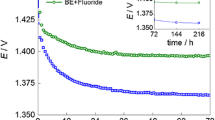Abstract
The effects of hydrogen evolution reaction on the deformation of zinc anode which cycles at nearly 100% depth of discharge (DOD) are studied. Results show that the generated hydrogen bubbles during charging process will gather on the surface of the middle of the anode and will cover the ZnO which is produced by the hydrolysis of Zn (OH)42− and prevent ZnO participation in the charging process. Since the charge-discharge reaction only occurs at the edges of the bubbles, the multiple dissolution and redeposition of the active material results in the formation of a massive ZnO and a very low specific discharge capacity. This finding provides a new perspective for the deformation of zinc anodes of the secondary alkaline zinc-based batteries.







Similar content being viewed by others
References
Jo YN, Kang SH, Prasanna K, Eom SW, Lee CW (2017) Shield effect of polyaniline between zinc active material and aqueous electrolyte in zinc-air batteries. Appl Surf Sci 422:406–412
Garcia G, Ventosa E, Schuhmann W (2017) Complete prevention of dendrite formation in Zn metal anodes by means of pulsed charging protocols. ACS Appl Mater Interfaces 9(22):18691–18698
Li Y, Dai H (2014) Recent advances in zinc–air batteries. Chem Soc Rev 43(15):5257–5275
Fu J, Lee DU, Hassan FM, Yang L, Bai Z, Park MG, Chen Z (2015) Flexible high-energy polymer-electrolyte-based rechargeable zinc–air batteries. Adv Mater 27(37):5617–5622
Park J, Park M, Nam G, Lee JS, Cho J (2015) All-solid-state cable-type flexible zinc-air battery. Adv Mater 27(8):1396–1401
Hu P, Wang T, Zhao J, Zhang C, Ma J, Du H, Wang X, Cui G (2015) 7. Ultrafast alkaline Ni/Zn battery based on Ni-foam-supported Ni3S2 nanosheets. ACS Appl Mater Interfaces 7(48):26396–26399
Liu J, Wang Y (2015) Preliminary study of high energy density Zn/Ni flow batteries. J Power Sources 294:574–579
Hoang TKA, Doan TNL, Sun KEK, Chen P (2015) Corrosion chemistry and protection of zinc & zinc alloys by polymer-containing materials for potential use in rechargeable aqueous batteries. RSC Adv 5(52):41677–41691
Mainar AR, Iruin E, Colmenares LC, Kvasha A, de Meatza I, Bengoechea M, Leonet O, Boyano I, Zhang Z, Blazquez JA (2018) An overview of progress in electrolytes for secondary zinc-air batteries and other storage systems based on zinc. J Energy Storage 15:304–328
Zhu AL, Wilkinson DP, Zhang X, Xing Y, Rozhin AG, Kulinich SA (2016) Zinc regeneration in rechargeable zinc-air fuel cells—a review. J Energy Storage 8:35–50
Sapkota P, Kim H (2009) Zinc–air fuel cell, a potential candidate for alternative energy. J Ind Eng Chem 15(4):445–450
Feng Z, Yang Z, Huang J, Xie X, Zhang Z (2015) The superior cycling performance of the hydrothermal synthesized carbon-coated ZnO as anode material for zinc–nickel secondary cells. J Power Sources 276:162–169
Xu M, Ivey DG, Xie Z, Qu W (2015) Rechargeable Zn-air batteries: progress in electrolyte development and cell configuration advancement. J Power Sources 283:358–371
Yang C, Zhang ZJ, Tian ZL, Zhang K, Li J, Lai YQ (2018) Communication—Bi@CMC composite as a multifunctional electrolyte channel for the anode of rechargeable Zn–Ni battery. J Electrochem Soc 165(2):A86–A88
Pei P, Wang K, Ma Z (2014) Technologies for extending zinc–air battery’s cyclelife: a review. Appl Energy 128:315–324
Garcia G, Schuhmann W, Ventosa E (2016) A three-electrode, battery-type Swagelok cell for the evaluation of secondary alkaline batteries: the case of the Ni-Zn battery. ChemElectroChem 3(4):592–597
Gwenaelle T, Stevens P, Akrour L, Rouget R, Fourgeot F (2010) Development of a rechargeable zinc-air battery. ECS Trans 28(32):25–34
Yang C, Zhang Z, Tian Z, Lai Y, Zhang K, Li J (2017) Effects of various carboxymethyl celluloses on the electrochemical characteristics of zinc anode from an alkaline electrolyte. Electrochim Acta 258:284–290
Mele C, Bilotta A, Bocchetta P, Bozzini B (2017) Characterization of the particulate anode of a laboratory flow Zn–air fuel cell. J Appl Electrochem 47(8):877–888
Choi KW, Bennion DN, Newman J (1976) Engineering analysis of shape change in zinc secondary electrodes: I. Theoretical. J Electrochem Soc 123(11):1616–1627
Choi KW, Bennion DN (1976) Engineering analysis of shape change in zinc secondary electrodes: II. Experimental. J Electrochem Soc 123(11):1628–1637
Funding
This work was supported by the University Natural Science Research Project of Anhui Province (NO. KJ2019A0145), Research Start-up Foundation of Anhui Polytechnic University (NO. 2018YQQ018), and National Natural Science Foundation of China (NO. 51974380).
Author information
Authors and Affiliations
Corresponding author
Additional information
Publisher’s note
Springer Nature remains neutral with regard to jurisdictional claims in published maps and institutional affiliations.
Rights and permissions
About this article
Cite this article
Yang, C., Liu, X., Yang, K. et al. Effects of hydrogen bubbles on deformation of zinc anodes at high depth of discharge. J Solid State Electrochem 25, 611–616 (2021). https://doi.org/10.1007/s10008-020-04838-1
Received:
Revised:
Accepted:
Published:
Issue Date:
DOI: https://doi.org/10.1007/s10008-020-04838-1




